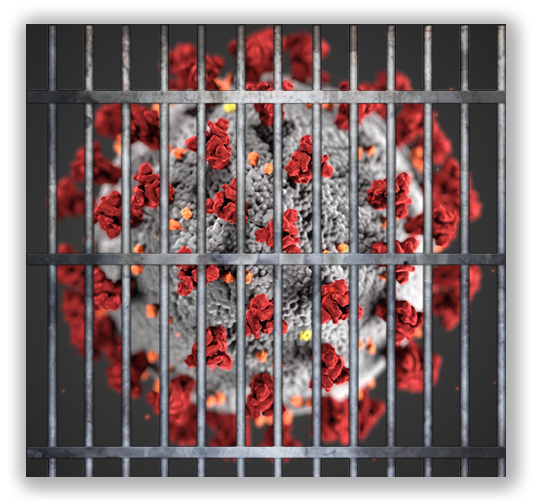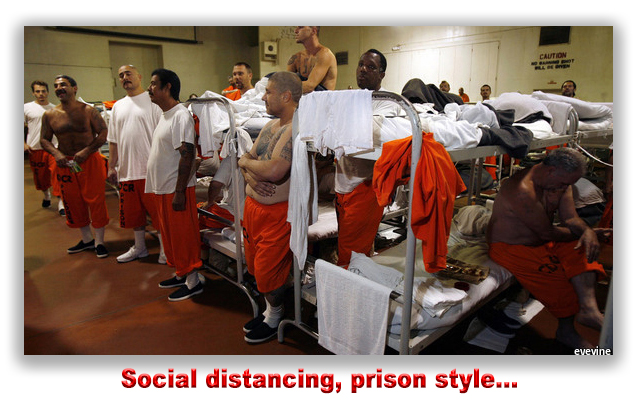We post news and comment on federal criminal justice issues, focused primarily on trial and post-conviction matters, legislative initiatives, and sentencing issues.

COVID-19 THIS WEEK
 The reopening of visitation, even with the restrictions the Federal Bureau of Prisons anticipates, suggests that the BOP is getting a handle on COVID-19. But the numbers hardly suggest that. As of last night, 1,834 inmates were sick, about the same as a week ago. Sick staff remained at 648, and only one additional inmate died during the week, bringing the total to 125. But COVID-19 remains stubbornly present in 113 institutions, 91% of Bureau of Prisons facilities, one more than a week ago.
The reopening of visitation, even with the restrictions the Federal Bureau of Prisons anticipates, suggests that the BOP is getting a handle on COVID-19. But the numbers hardly suggest that. As of last night, 1,834 inmates were sick, about the same as a week ago. Sick staff remained at 648, and only one additional inmate died during the week, bringing the total to 125. But COVID-19 remains stubbornly present in 113 institutions, 91% of Bureau of Prisons facilities, one more than a week ago.
A disturbing report from the Council for Criminal Justice issued last week found that the COVID-19 mortality rate within prisons is 61.8 deaths per 100,000 inmates, twice that of the general public mortality rate, even adjusted for the sex, age and race or ethnicity of those incarcerated. The rate of COVID-19 cases reported by state and federal prisons is nearly 7,000 cases per 100,000 people in prison, more than four times the rate of confirmed cases per 100,000 US residents. Geographically, prisons with the highest number of COVID-19 cases are those located in the southern region of the U.S., and in prisons with over 1,000 inmates. The highest COVID-19 mortality rates come from large prisons and those in the midwest. Overall, the BOP COVID mortality rate is twice that of the general population.
A Minnesota TV station reported last Friday that Ambjar Anderson, the chief steward of the BOP staff union at FCI, told reporters that a month ago “the prison received a couple of buses of inmates. One bus was mostly comprised of positive COVID-cases.”

“We’ve had the proper PPE in place and that’s what helped us mitigate things so far,” Anderson was quoted as saying, but “it’s really hard when the Bureau sends a busload of them. The numbers – it’s spreading – because it’s a prison and it’s hard to social distance.”
Anderson told the station that “we have staff who have families and communities that they are living in and going to and they care about and they don’t want to pass it around to everyone, yet now it’s spreading in our institution.”
A US Sentencing Commission study of the first year of the First Step Act, released last week, reported that 145 motions seeking compassionate release were granted through the end of September 2019, a five-fold increase from fiscal year 2018. Two thirds were filed by the defendant, one third by the BOP. The average length of the sentence reduction was 68 months in fiscal 2018; 84 months in 2019. The average months of time served at the time of release also increased from 70 months to 108 months.
 No stats are yet available for the COVID-19 series of compassionate releases. However, last week a Colorado Politics review of 42 court opinions issued between March 1 and August 31 the District of Colorado found that only in five coronavirus-related instances did a judge agree to “compassionate release.” Two judges who oversaw half of the requests did not grant a single release. One of them contended that an inmate who contracted COVID-19 in prison should remain there so as not to infect others.
No stats are yet available for the COVID-19 series of compassionate releases. However, last week a Colorado Politics review of 42 court opinions issued between March 1 and August 31 the District of Colorado found that only in five coronavirus-related instances did a judge agree to “compassionate release.” Two judges who oversaw half of the requests did not grant a single release. One of them contended that an inmate who contracted COVID-19 in prison should remain there so as not to infect others.
Council on Criminal Justice, COVID-19 in State and Federal Prisons (September 2, 2020)
KIMT-TV, Rochester, Minnesota, Outbreak Concerns at FCI Waseca (September 4, 2020)
US Sentencing Commission, The First Step Acct: One Year of Implementation (Aug 31)
Colorado Politics, Federal judges in Colorado granted 12% of pandemic-related early release requests (September 1, 2020)
– Thomas L. Root

